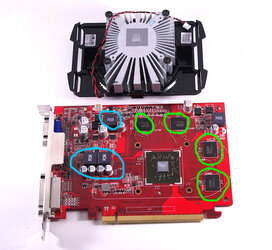Hello all, I'm new to this forum, new as a member but reading it for a long time.
I have some spare time and Asus R7 250 graphics card that I want to make a new air cooling for. The reason for that is a very crappy factory cooler which doesn't just sound awful, but started to sound "loosened" at it's shaft, making clicking sound at it's default 40% speed.
I've been modding coolers on some graphics and processors before, but this time, I was wondering if I could go for 0 db (no fan).
So my question is: how does big aluminum block work as a heatsink? I have some aluminum plate which is about 12mm thick, so I was thinking of putting lots of metal mass so it will compensate for the fan.
Also, I guess it would make it more "inertial" as it would heat/cool much slower than small fan blown with fan which now cools from 80c to 30c in 30 seconds.
One more thing: Do parts (marked on picture) need a heatsink? They don't have heatsink now but the fan blows over them for sure.

- - - Updated - - -
Forgot to mention, after installing a big CPU heatsink over the GPU chip and fan which wasn't blowing other parts of the card, the monitoring software was reading 50c at idle and going over 100c easily while at load. Does the temperature sensor measure any other part?
I have some spare time and Asus R7 250 graphics card that I want to make a new air cooling for. The reason for that is a very crappy factory cooler which doesn't just sound awful, but started to sound "loosened" at it's shaft, making clicking sound at it's default 40% speed.
I've been modding coolers on some graphics and processors before, but this time, I was wondering if I could go for 0 db (no fan).
So my question is: how does big aluminum block work as a heatsink? I have some aluminum plate which is about 12mm thick, so I was thinking of putting lots of metal mass so it will compensate for the fan.
Also, I guess it would make it more "inertial" as it would heat/cool much slower than small fan blown with fan which now cools from 80c to 30c in 30 seconds.
One more thing: Do parts (marked on picture) need a heatsink? They don't have heatsink now but the fan blows over them for sure.

- - - Updated - - -
Forgot to mention, after installing a big CPU heatsink over the GPU chip and fan which wasn't blowing other parts of the card, the monitoring software was reading 50c at idle and going over 100c easily while at load. Does the temperature sensor measure any other part?